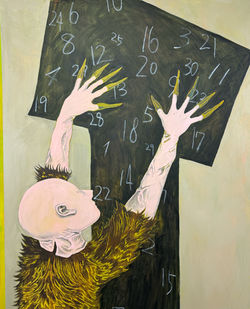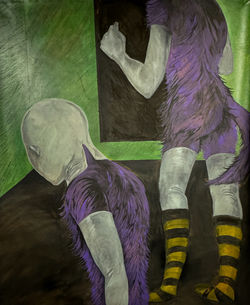Tang Contemporary Art is delighted to announce the unveiling of the solo exhibition "Quadruped Masking" by the Japanese artist Kaito Itsuki on April 27th, 2024, at 4 p.m. at its Headquarters Space in Beijing. This marks Kaito Itsuki's second solo exhibition at Tang Contemporary Art following her previous showcase, "Tools are validated". Curated by Fiona Lu and Huang Ying, the exhibition will present twenty captivating new paintings by Kaito Itsuki.
Kaito Itsuki's artistic practice is characterized by her adept utilization of a personal mythological framework to construct a space that transcends reality and imagination. Through this, she provides insights into the authentic selves and desires of individuals amidst societal norms and constraints. The title of the exhibition, "Quadruped Masking", is drawn from Itsuki's eponymous new series of works. "Quadruped" typically refers to animals or machines that maintain a four-legged posture and movement, while "masking" denotes the act of concealment and disguise through the use of masks. The depiction of characters adopting a four-limbed posture, unlike the typical human stance, in Itsuki's visual language hints at their humanoid yet non-human essence. These figures, continuing Itsuki's established mythological imagery, are portrayed donning vibrant head coverings and socks, and are placed in various postures within bathroom or indoor settings with mattresses. Through this imagery, Itsuki explores themes of self-identity formation and the quest for individuality, as well as the endeavor to assimilate into societal norms and perform human behaviors within social contexts.
In comparison to quadrupedal creatures, the toes ensconced beneath the striped socks worn by the figures in the artwork are perceived by Georges Bataille as emblematic of both the "filth" rejected by modern civilization and the pivotal support for human bipedalism. If it serves to distinguish humanity from quadrupeds, it stands as a poignant symbol of the transition from savagery to civilization, while the exposed fur may allude to the untamed aspect of human nature that defies universal constraint. Resistant to discipline, irrecoverable as a productive entity within a meritocratic society, and devoid of any lofty aspiration, this "superfluous" animality in Kaito Itsuki's heterogeneous realm signifies an inescapable and profound facet of the human identity's journey toward socialization. Despite its attempts at concealment beneath deliberate guises, it persistently and surreptitiously manifests itself in various settings, whether rigorously controlled or private. Embedded within Kaito Itsuki's envisioned clumsy masquerade of spiritual beasts lies the intricate complexity of human internal identity and the tumultuous forms of identity realization.
Kaito Itsuki's paintings heighten our sensory experience through a captivating interplay between the depicted environments (running showers, compressed mattresses) and implied actions (skin testing water temperature, scratching surfaces) referenced in the titles. The vibrant canvases are further charged with subtle fetishistic and masochistic undertones through the use of materials like silicone masks and gloves, full-body Zentai suits, scattered bandages, and ordinary tools. The faint smiles on the headgear add an unsettling, uncanny element, provoking a mixture of instant pleasure and discomfort in the viewer. Drawing on Freudian psychoanalysis, the fetishistic tendencies hinted at in the works suggest a binding to fixed symbolic relationships with objects. These objects become a repressed state of personal symbolic expression, yearning for liberation. However, the use of silicone, a potent material in popular culture known for its unique flexibility, takes on a more subversive quality. It becomes a "liquid skin" with queer connotations, reflecting a consumer society obsessed with performance and the pliability of self-presentation. As the figures don this "liquid skin," it results in a paradoxical experience: heightened sensory awareness alongside deprivation, a simultaneous sexualization and desexualization. This self-contradiction resonates with anthropologist Claude Lévi-Strauss's exploration of masks in culture. Like myths, masks operate on a dualistic level: affirming and denying. A mask, as Claude Lévi-Strauss suggests, "comes not only from what it expresses or what it believes it can express, but also from what it excludes." The friction between the fur and silicone in Itsuki's works goes beyond the physical presence of the body. It confirms the boundaries between the body and the world while simultaneously blurring them. This act of blurring provides a temporary respite from the deep-seated anxiety individuals face as they integrate into society.
Donning disguises for social entry presents a double-edged sword. Masks, while offering a sense of security through anonymity, can also trigger fear and discrimination from a society unable to recognize the individual beneath. Yet, human existence relies on social interaction and understanding others (differentiating ourselves from them) for both survival and self-definition. Kaito Itsuki particularly highlights this profound desire: disguise becomes a necessary tool for connection, even if we deviate significantly from the social "norm." This act of disguise becomes a performative embodiment driven entirely by inner yearning. The disguised individual endures a paradoxical torment, simultaneously suffering and strangely finding pleasure in the process. Amidst the struggle and loss of control, we are forced to confront critical questions: How much of the self is eroded or sacrificed in forging connections with others? How can we fulfill this deep-seated desire while maintaining individual autonomy and a sense of self? In Itsuki's paradoxical mythology, "quadruped masking" functions as both a noun and an action. The mythical beast dons a human mask, a disguise that facilitates its cautious exploration of its place within society and the boundaries between self and other.
 Fun maskOil and charcoal on canvas 132 x 96 cm 2023 |  Looming Digits (How to catch things)Oil and charcoal on canvas 150 x 180 cm 2023 |  Falling to bedOil and charcoal on canvas 160 x 180 cm 2024 |
|---|---|---|
 Matt Silicone Textured SocksOil and charcoal on canvas 181 x 224 cm 2024 |  Tight intelligence (woven belts)Oil and charcoal on canvas 162 x 130 cm 2023 |  Looming Digits (Hiding Tiger tale)Oil and charcoal on canvas 162 x 130 cm 2023 |
 Offering of MarchOil and charcoal on canvas 130.3 x 130.3 cm 2024 |  A Quadruped MaskingOil and charcoal on canvas 130 x 97 cm 2024 |  Veneer on Yellow FurOil and charcoal on canvas 160 x 130 cm 2024 |
 Numerical Point with NailsOil and charcoal on canvas 160 x 130 cm 2024 |  Imprint on Contours (Blue)Oil on canvas 162 x 112 cm 2024 |  Imprint on Contours (Red)Oil on canvas 112 x 162 cm 2024 |
 Homecoming RitualsOil and charcoal on canvas 180 x 160 cm 2024 |  Temperature CheckingOil on canvas 181 x 224 cm 2024 |  Socks onOil and charcoal on canvas 160 x 130 cm 2024 |
 Package ArrivalOil on canvas 100 x 73 cm 2024 |  Still-life (Night Time)Oil and charcoal on canvas 91 x 73 cm 2024 |  Orange FurOil on canvas 100 x 73 cm 2024 |
 Before LeavingOil on canvas 91 x 73 cm 2024 |
Artists

Kaito Itsuki
Kaito Itsuki is a painter born in 1993, in Sapporo, Hokkaido, and is currently based in Tokyo and New York. Kaito's hometown of Sapporo had few opportunities for seeing art in person so much of her aesthetic influences came from anonymous images floating around the internet, video games, or comics. Staying in Sapporo until she graduated from a local arts high school, she then studied painting at Tohoku University of arts and design. Kaito also studied cultural anthropology, comparative religion and youth cultures which provided inspiration for the themes of her art works. Afterwards, she received a MFA from Kyoto city university of arts and in 2019, moved to Tokyo and then NYC to pursue her art career. Kaito Itsuki’s art works have been shown internationally including Clear gallery Tokyo (Tokyo, Japan), Art fair Philippines (Manila, Philippine), PDX contemporary art (Portland, US), and Tang Contemporary Art (Beijing, China).



